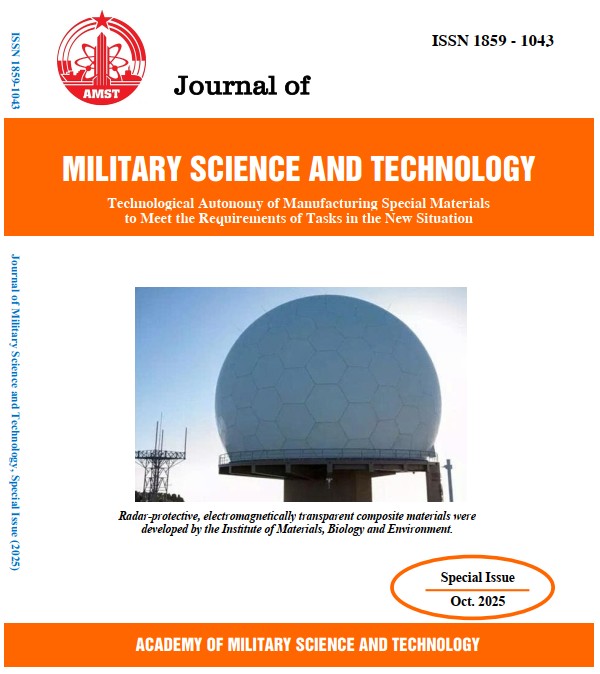Development of TiO₂@porphyrin nanocomposites as photoelectrochemical materials for water splitting in hydrogen production
DOI:
https://doi.org/10.54939/1859-1043.j.mst.IMBE.2025.221-227Keywords:
Photoelectrochemical water splitting; TiO2@porphyrin hybrid material; Green hydrogen; Self-assembly.Abstract
Photoelectrochemistry (PEC) is a technology that integrates light absorption on semiconductor materials with electrode-driven oxidation and water-splitting processes, producing oxygen and hydrogen. In this study, we report the synthesis of TiO2@porphyrin hybrid materials by the self-assembly method and evaluate the photocatalytic water splitting ability of the hybrid materials. Analytical methods such as UV-vis, SEM, cyclic voltammetry (CV), electrochemical impedance spectroscopy (EIS) and linear sweep voltammetry (LSV) were used to determine the hybrid material formation and photoanode performance. The nanomaterials were synthesized by the self-assembly method with a fiber structure of 30-50 nanometers in diameter and several micrometers in length. The results showed that TiO2@porphyrin nanomaterials have potential applications in H2 production from water.
References
[1]. Hu, C., L. et al., “Recent progress made in the mechanism comprehension and design of electrocatalysts for alkaline water splitting,” Energy & Environmental Science, 12(9), pp. 2620–2645, (2019).
[2]. Leijtens, T., et al., “Opportunities and challenges for tandem solar cells using metal halide perovskite semiconductors,” Nature Energy, 3(10), pp. 828–838, (2018).
[3]. Dotan, H., et al., “Decoupled hydrogen and oxygen evolution by a two-step electrochemical–chemical cycle for efficient overall water splitting,” Nature Energy, 4(9), pp. 786–795, (2019).
[4]. Zhao, Z., et al., “Molecules interface engineering derived external electric field for effective charge separation in photoelectrocatalysis,” Nano Energy, 42, pp. 90–97, (2017).
[5]. Fujishima, A. and K. Honda, “Electrochemical photolysis of water at a semiconductor electrode,” Nature, 238(5358), pp. 37–38, (1972).
[6]. Fujishima, A. and K. Honda, “Electrochemical evidence for the mechanism of the primary stage of photosynthesis,” Bulletin of the Chemical Society of Japan, 44(4), pp. 1148–1150, (1971).
[7]. Zhang, C., et al., “Porphyrin supramolecular 1D structures via surfactant‐assisted self‐assembly,” Advanced Materials, 27(36), pp. 5379–5387, (2015).
[8]. Bhosale, S. V. and D. Duc La, “Nanoscale porphyrin superstructures: properties, self-assembly and photocatalytic applications,” (2018).
[9]. La, D. D., et al., “Advances and prospects of porphyrin-based nanomaterials via self-assembly for photocatalytic applications in environmental treatment,” Coordination Chemistry Reviews, 463, p. 214543, (2022).
[10]. Wang, X., et al., “An ultrathin porphyrin-based metal-organic framework for efficient photocatalytic hydrogen evolution under visible light,” Nano Energy, 62, pp. 250–258, (2019).
[11]. Uscategui. L, A., et al., “Photocatalytic activity of a 2D copper porphyrin metal–organic framework for visible light overall water splitting,” Nanoscale Advances, 6(23), pp. 5971–5977, (2024).
[12]. Chen, Y., et al., “One-step growth of organic single-crystal p–n nano-heterojunctions with enhanced visible-light photocatalytic activity,” Chemical Communications, 49(80), pp. 9200–9202, (2013).
[13]. Li, D., et al., “Photocatalytic degradation of acid chrome blue K with porphyrin-sensitized TiO2 under visible light,” The Journal of Physical Chemistry C, 112(38), pp. 14878–14882, (2008).
[14]. Bhat, S. S., et al., “Influence of C3N4 precursors on photoelectrochemical behavior of TiO2/C3N4 photoanode for solar water oxidation,” Energies, 13(4), p. 974, (2020).
[15]. Zhang, N., et al., “Facile synthesis of CdS–ZnWO4 composite photocatalysts for efficient visible light driven hydrogen evolution,” International Journal of Hydrogen Energy, 42(4), pp. 1962–1969, (2017).







